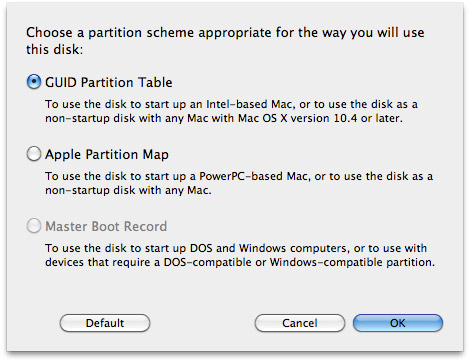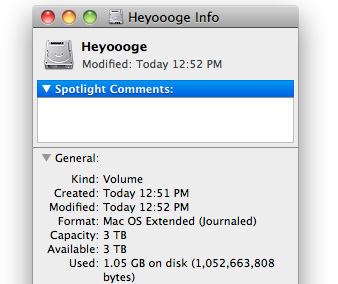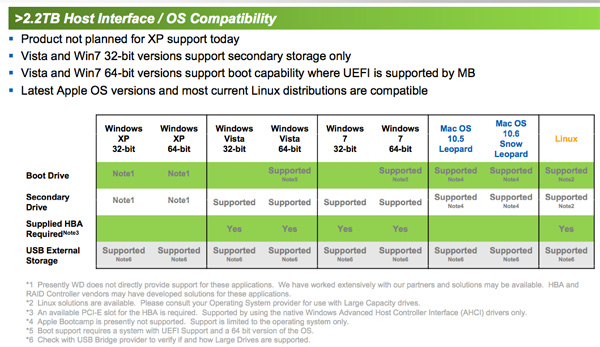Western Digital Caviar Green 3TB and My Book Essential 3TB Drives Reviewed
by Anand Lal Shimpi on October 19, 2010 1:43 PM EST- Posted in
- Storage
- HDDs
- Western Digital
- 3TB
The 2.19TB Barrier
I addressed this in my 3TB Seagate review back in August, so much of this is a rehash from the review back then with some new information toward the end of the page.
Pretty much all HDDs (and SSDs) are addressed using a scheme called Logical Block Addressing (LBA). The method is very, well, logical. Storage is addressed linearly, regardless of how the hardware itself is accessed. You start at LBA 0 and you go all the way up to the last address in your device.
The number of LBAs you can address is a function of your hardware and the style of partition you’ve applied to your drive.
Master Boot Record partitioning is by far the most common on PCs today. LBA 0 contains the Master Boot Record (MBR) and your BIOS looks at the contents of LBA 0 to determine how to boot.
Now LBAs under MBR partitions are addressed using 32-bit values, the maximum of which is 2^32 or 4294967296. Each LBA on a hard drive corresponds to a 512-byte sector value (even on 4K advance format drives, they still appear as 512-byte sector drives to the OS), so the largest partition you can have in a MBR partitioned drive is 4294967296 * 512-bytes or 2,199,023,255,552 bytes.
Hard drive manufacturers define 1TB as 1 trillion bytes. If we use that definition then the largest 32-bit MBR partition would be 2.199TB (2,199,023,255,552 bytes / 1,000,000,000,000). If we define 1TB as 1024^4 bytes (TiB) then the largest 32-bit MBR partition would be 2TiB (2,199,023,255,552 bytes / 1,099,511,627,776). Either way, with a 3TB drive there’s no way we’re getting a single 3TB partition using MBR.
In use on all Itanium and Intel based Macs (among other systems) is GPT (GUID Partition Table), and a feature of GPT is 64-bit LBA support.
With 64-bit LBAs the largest 512-byte sector drive we can address is 9.4ZB (Zettabytes - 10^21 or 2^70 bytes depending on if you’re counting in base 10 or 2). That’s an absurd amount of data.
GPT drives are supported as data drives in all x64 versions of Windows as well as Mac OS X and Linux. Below we have some screenshots of creating a GPT drive in Windows and OS X:

GPT Partition in Windows 7

GPT in Mac OS X
You’ll note that I said data and not boot drives. In order to boot to a GPT partition, you need hardware support. I just mentioned that your PC’s BIOS looks at LBA 0 for the MBR. Your BIOS does not support booting to GPT drives. GPT is however supported by systems that implement the successor to the BIOS: Intel’s Extensible Firmware Interface (EFI).
Intel based Macs don’t use a BIOS and instead have an EFI which allows them to boot to GPT drives. Most PC motherboards however do not have EFI support, and those that do may have bugs associated with the implementation.
I’m expecting to see the first round of motherboards with official 3TB HDD support in the coming weeks. Although consumers shouldn’t expect good support from motherboard makers until the first half of next year. Users of older boards may be out of luck as enabling EFI is still a low priority for most manufacturers.
BIOS support is only part of the problem. You SATA controller also needs to support 64-bit LBAs. Currently Intel’s storage drivers don’t support 64-bit LBAs. Running your ICH in Native IDE mode will work however.
AMD’s 8-series storage drivers do support 64-bit LBAs but I haven’t seen any AMD motherboards with EFI support.
In order to deal with all of the potential controller issues today, Western Digital bundles all 3TB drives with a HighPoint Rocket 620. The controller supports booting to a 3TB formatted drive if your motherboard has EFI support. But as I just mentioned, proper EFI support is tough to come by.

Western Digital expects that we’ll see both motherboard and storage controller support by Q2 2011, at which point it will stop shipping the HighPoint cards with 3TB drives.
The HighPoint adapter uses a Marvell 88SE9025 6Gbps SATA controller, although for some reason installing HighPoint’s drivers on the card (both at boot and under Windows) would cause the drive to disappear entirely. I had to rely on the drivers that ship with Windows 7.
Mac & Linux Support
Intel Macs already ship with EFI support so these drives should just work in a Mac. I popped one into a Nehalem Mac Pro and I confirmed it worked:

Linux is also covered if your distribution enables support for 64-bit LBAs. The full compatibility matrix is below:











48 Comments
View All Comments
krumme - Tuesday, October 19, 2010 - link
Can we perhaps see this in a My Book World Edition?Thanx for the fine HD reviews Anand
ervinshiznit - Tuesday, October 19, 2010 - link
So with the 32 bit LBA restriction, does this mean that its possible to boot from a partition on a 3TB drive as long as that partition is no larger than 2.1TB?davepermen - Tuesday, October 19, 2010 - link
And it's especially nice that the old small 2TB drives are now really cheap. Put a new one to celebrate into my windows home server. The 3TB ones won't be supported for whs1 anyways, so it's cheap 2TB drives from now on.Then, when the 3TB will be in the same price/gb ratio, the next disk will be needed, and whs2 will be there, supporting them.
And yes, storage (in my case, networked storage thanks to whs) + ssd in the systems is definitely the best setup. 100% agreed.
ratbert1 - Tuesday, October 19, 2010 - link
"The controller supports booting to a 3TB formatted drive if your motherboard has EFI support."The chart shows support for boot with 64 bit Vista and 7 with the HBA controller. If you have 32 bit, you can use it as a data drive.
SteelCity1981 - Tuesday, October 19, 2010 - link
It's totally pointless to make 6gb platter hard drives. At least WD understands that.Taft12 - Tuesday, October 19, 2010 - link
Nobody makes 6GB/platter drives... at least not since 1999!SteelCity1981 - Wednesday, October 20, 2010 - link
I'm talking speed not size duh.Roland00Address - Tuesday, October 19, 2010 - link
Western Digital Caviar Black WD6402AAEX 640GB 7200 RPM SATA 6.0Gb/s 3.5"Western Digital Caviar Black WD1002FAEX 1TB 7200 RPM SATA 6.0Gb/s 3.5"
Western Digital VelociRaptor WD4500HLHX 450GB 10000 RPM SATA 6.0Gb/s 3.5"
Western Digital VelociRaptor WD6000HLHX 600GB 10000 RPM SATA 6.0Gb/s 3.5"
bennyg - Saturday, October 23, 2010 - link
If you were uninformed, you would think a SATA 6GBPS 3TB HDD is faster than a SATA 3GBPS 3TB HDD. So marketing people think it's very useful.ytoledano1 - Tuesday, October 19, 2010 - link
In most cases, data is lost due to user error, virus, theft or fire - RAID1 protects against none of these. RAID1 will protect you against disk failure, but its main advantage is in mission-critical servers where you don't want to reboot the machine when replacing a drive. How many desktop users need this feature?Worst, people might think that their data is backed up 'cause their disk is redundant. It's not.